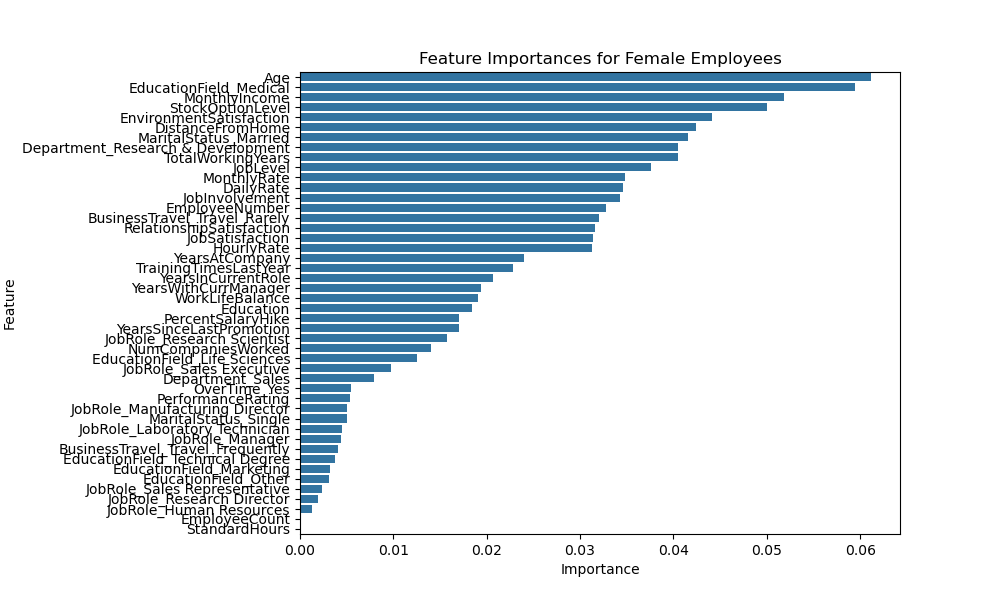Gender-Based Analysis of Employee Attrition Prediction Using Machine Learning
Keywords:
Employee Attrition, Machine Learning, Gender Analysis, Random Forest, Shap ValuesAbstract
Employee turnover is a significant problem in organizations because it comes with productivity and cost implications. This paper focuses on predicting employee turnover using machine learning techniques that incorporate gender aspects. We used strong Random Forest classifiers to predict attrition based on a wide cross-section of the employees’ activities and the feature importance assessment. The procedure involved data cleaning, splitting the dataset for males and females, creating models for them, and using assessment tests with different measures. When we separated the data base by gender, our analysis identified unique factors that predisposed the two groups to dropping out. The importance of features, the ROC curve, and the SHAP map showed how variables such as "job role," "monthly income," and "work-life balance" affected attrition differently between males and females. For female employees, job satisfaction and time directly influenced attrition, whereas for male employees, previous companies and distance from home had a greater impact. The results of the research therefore imply the need for gender-sensitive HR practices that can inform the development of gender-sensitive accommodation policies as a way of responding to the challenges facing each gender. This approach aids in the explanation of attrition tendencies and the provision of better organizational practices.
References
D. G. Allen, L. M. Shore, and R. W. Griffeth, “The Role of Perceived Organizational Support and Supportive Human Resource Practices in the Turnover Process,” J. Manage., vol. 29, no. 1, pp. 99–118, Feb. 2003, doi: 10.1177/014920630302900107.
M. Adamovic, “Organizational justice research: A review, synthesis, and research agenda,” Eur. Manag. Rev., vol. 20, no. 4, pp. 762–782, Dec. 2023, doi: 10.1111/EMRE.12564.
S. M. Lundberg and S. I. Lee, “A Unified Approach to Interpreting Model Predictions,” Adv. Neural Inf. Process. Syst., vol. 2017-December, pp. 4766–4775, May 2017, Accessed: Aug. 14, 2024. [Online]. Available: https://arxiv.org/abs/1705.07874v2
L. Breiman, “Random forests,” Mach. Learn., vol. 45, no. 1, pp. 5–32, Oct. 2001, doi: 10.1023/A:1010933404324.
“(PDF) Classification and Regression by RandomForest.” Accessed: Aug. 14, 2024. [Online]. Available: https://www.researchgate.net/publication/228451484_Classification_and_Regression_by_RandomForest
P. E. Spector, “Job Satisfaction: Applications, Assessment, Causes and Consequences,” Job Satisf. Appl. Assessment, Causes Consequences, Jan. 1997, doi: https://doi.org/10.4135/9781452231549.
“Allen, D. G., shore, L. M., & Griffeth, R. W. (2003). The Role of Perceived Organisational Support and Supportive Human Resource Practices in the Turnover Process. Journal of Management, 29, 99-118. - References - Scientific Research Publishing.” Accessed: Aug. 14, 2024. [Online]. Available: https://www.scirp.org/reference/referencespapers?referenceid=2387618
“(PDF) Influence of Compensation on Employee Turnover at Galitos.” Accessed: Aug. 14, 2024. [Online]. Available: https://www.researchgate.net/publication/352738251_Influence_of_Compensation_on_Employee_Turnover_at_Galitos
“(PDF) Impact of Career Advancement on Employee Retention.” Accessed: Aug. 14, 2024. [Online]. Available: https://www.researchgate.net/publication/368273690_Impact_of_Career_Advancement_on_Employee_Retention
F. Fallucchi, M. Coladangelo, R. Giuliano, and E. W. De Luca, “Predicting Employee Attrition Using Machine Learning Techniques,” Comput. 2020, Vol. 9, Page 86, vol. 9, no. 4, p. 86, Nov. 2020, doi: 10.3390/COMPUTERS9040086.
M. Pratt, M. Boudhane, and S. Cakula, “Employee Attrition Estimation Using Random Forest Algorithm,” Balt. J. Mod. Comput., vol. 9, no. 1, pp. 49–66, 2021, doi: 10.22364/BJMC.2021.9.1.04.
W. A. Al-Suraihi, S. A. Samikon, A.-H. A. Al-Suraihi, and I. Ibrahim, “Employee Turnover: Causes, Importance and Retention Strategies,” Eur. J. Bus. Manag. Res., vol. 6, no. 3, pp. 1–10, Jun. 2021, doi: 10.24018/EJBMR.2021.6.3.893.
D. R. S. Kamath, D. S. S. Jamsandekar, and D. P. G. Naik, “Machine Learning Approach for Employee Attrition Analysis,” Int. J. Trend Sci. Res. Dev., vol. Special Issue, no. Special Issue-FIIIIPM2019, pp. 62–67, Mar. 2019, doi: 10.31142/IJTSRD23065.

Downloads
Published
How to Cite
Issue
Section
License
Copyright (c) 2024 50SEA

This work is licensed under a Creative Commons Attribution 4.0 International License.




















